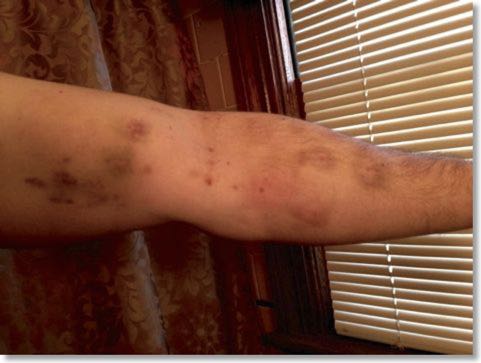Protection Bite Work Gets the Blood Going (& Sometimes Flowing)
The aftermath of yesterday’s training sessions.
The great thing about working with undercover training equipment is that you can cover it with clothing the dogs have never seen before. They don’t rely on seeing any equipment to turn on aggressively, protect their handler off-leash or go for the bite. Of course, there’s no such thing as a free lunch, and this picture does a good job of showing what our protection dog trainers’ arms can look like on any given day.
The thin materials we use prevent most punctures and help to distribute the power of the dog’s jaw more evenly, but there’s no avoiding the crushing and pinching that comes along with bite work. It can certainly hurt (especially toward the end of a hard week of training when even your bruises are getting bruises), but it’s the best way to train personal protection dogs. We got into this business because we’re passionate about family security and dogs, so we accept the fact that we don’t have the luxury of wearing bulky equipment or face masks. When we do “accessorize,” it’s so that we can expose the dogs to weapons, masks, and other potential variables they might encounter. As you can see in our videos, we attempt to emulate different responses that a threat might have to being bitten- from intense yelling to a more passive “play dead” approach.
Surprise attacks are one of the biggest tools that criminals have in their arsenal, but we take that advantage away by training each dog to go from 0-60 without any “warm up” period needed. When our dogs are least expect it, a decoy threat will appear out of nowhere. It’s amazing how quickly they go from fetching a ball to forcing away a threat.
 Update 4/25/2013: Here’s a bruise from last week (left) vs. this week (right). Ouch.
Update 4/25/2013: Here’s a bruise from last week (left) vs. this week (right). Ouch.
If you have a question about our protection dog training, don’t hesitate to send us a message.
